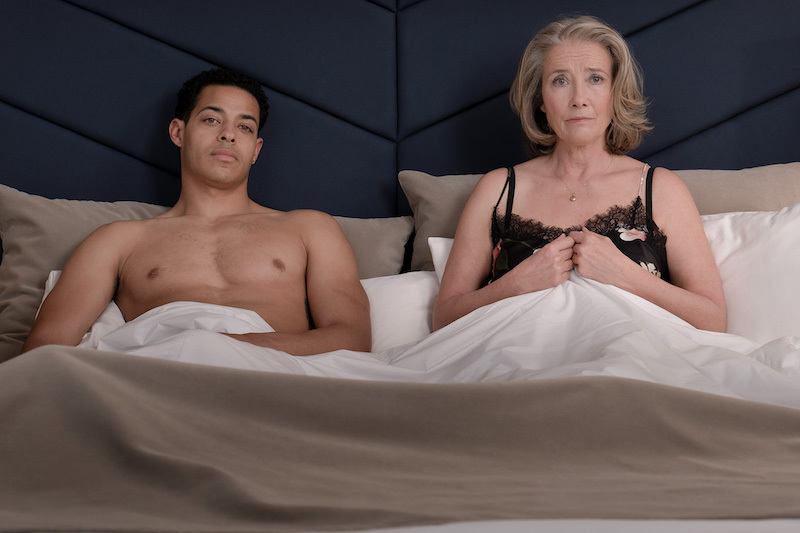
“Do you masturbate?” Sarah, an older woman I trusted, asked me when I was 18.
“No!” I said, giving a definitive answer.
“If you can’t give yourself an orgasm, no one else will.”
I thought about this exchange while watching Good Luck to you, Leo Grande, starring Emma Thompson as Nancy Stokes and Daryl McCormack as Leo Grande. The film tells the story of a widowed woman who hires a young male sex worker to experiment with in ways she never did with her husband—the only person with whom she’s had physical intimacy for three decades. But the film is, among other things, an exploration of whether women due to internal and external messaging, are allowed to pursue and attain sexual fulfillment. The fact that Nancy has never had an orgasm answers that question.
In a world where we’ve started discussing the critical importance of sexual consent, and in the wake of #MeToo, we must address women’s pleasure—making this film not only entertaining, but necessary.
So, why can’t women enjoy these amazing bodies we’ve been given? For one, our concern with how our bodies look from the outside affects how, and how much, we feel on the inside. One study shows that at age 13, half of American girls say they are “unhappy with their bodies.” This number grows to 80 percent by the time girls turn 17.
Just as sexuality is blossoming, it’s nipped in the bud by intrusive, and often obsessive, thoughts about how we look to others. And issues with body image don’t go away. Nearly 70 percent of adult women report withdrawing from activities due to negative body image. These thoughts keep us women in our heads and if we’re in our heads, we can’t be in our bodies which is where we must be to feel pleasure. The media makes all this worse because only 5 percent of us women will meet the physical ideal presented there.
With all this focus on our size, age and appearance, we forget that the most remarkable thing about our physical form happens on our insides—that our bodies are, as Nancy says, “a thing of wonder, a playground of delight.” The clitoris has 8,000 nerve endings, twice the amount as the penis and is made up of 18 distinct parts. My 22-year-old son’s sexually savvy friends speak openly about their sex toys, yet the ones with vaginas don’t know that their clitorises have legs—called the crura—the knowledge of which would make their erotic reach even more mind-blowing than the USB rechargeable-oral-sex-simulating feats of technology found today.
Body positivity and sex toy advertisements on the New York City subway are progress but can’t quite counteract the effects of sexual assault and rape. Eighty-one percent of women report experiencing some form of sexual harassment and/or assault in their lifetime and 20 percent have been the victims of an attempted or completed rape.
Sexual trauma in my youth presented two conditions that for years prevented me from feeling good. One was vaginismus, an involuntary tightening of the vaginal walls brought on by fear of penetration making sex painful and even physically impossible. And the other was anorgasmia—the inability to have an orgasm. I could relate to Nancy’s plight. Statistics show that 95 percent of straight men reported having orgasms to straight women’s 65 percent. We, bisexual women, had a 66 percent rate, and for lesbian couples it was better with women reporting a rate of 86 percent. Five to 10 percent of women have never had an orgasm at all. So, what’s keeping any of us who wants a climax from having one? It’s clear.
Seeing our bodies as flawed and experiencing sexual violations prevent us from feeling pleasure. At 49, I am no longer an occasional visitor to this body, but a full-time resident. It took a whole lot to get here. For years, I punished my body by vacating it, but the more I lived in my body and loved it, the more pleasure became possible. It’s as if pleasure carved out new neural pathways—the more pleasure I allowed in, the more healed and whole I felt.
The look of contentment Nancy has as she gazes upon her naked body in the final scene is less about how that body looks and more about what that body is now permitted to feel. In an interview on NPR, Thompson said, “She’s seeing [her body] for the first time as her home.” And like a house itself, her body is illuminated from the inside out. Beauty doesn’t come from the outside like we’ve been lead to believe—it radiates out from self-acceptance and love. In fact, real beauty comes from our ability to feel—it comes from pleasure.
For Nancy, it takes more than half a lifetime and 93 minutes of a 97-minute movie to come. While it took me a little less than that to go from zero orgasms to being multi-orgasmic, it’s worth mentioning because on the other side of my painful struggle I can say with certainty that pleasure is each of our birthrights no matter how we look or what’s been done to us.
What my friend Sarah said all those years ago was correct. “If you can’t give yourself an orgasm, no one else will.” An orgasm, after all, is not something you give someone; it’s a gift you give yourself. Only we can decide to let go, to receive, to empty ourselves of all the crippling beliefs and thoughts and past violations—and be filled and full with pleasure.
For this reason, midway into the movie and for as much as I loved the adorable Leo Grande, I started hoping that our protagonist would give herself her first orgasm—and I was so grateful when she did, because pleasure starts with ourselves. It’s a decision. A choice. And as Nancy says, “Pleasure is a wonderful thing, it’s something we should all have.”
Up next:





